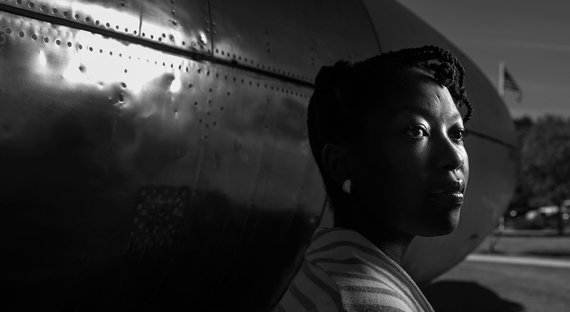25 Faces 25 Years: Christina Achampong
By Maria Zankey
Photo by Jared Castaldi
 Christina Achampong, Operations Researcher, National Security Agency
Christina Achampong, Operations Researcher, National Security Agency
March 8, 2017
It takes a certain type of person to work — and thrive — at the National Security Agency.
It takes discretion, considering the organization collects and protects sensitive and classified information for the United States government.
It takes intelligence, working among the best and brightest minds in America to think comprehensively and solve complex, high-level problems.
And it takes resilience, assuming responsibility within an agency whose work is critical to the safety and well-being of every American — work that can never be openly discussed, even with those closest to you.
Christina Achampong, an operations researcher for the NSA and 2006 Drexel mathematics alumna, says she owes her sense of resiliency to her teachers, her role as an RA, her extracurricular activities and her three co-ops at Drexel.
After co-op positions in accounting and auditing at Giant Food, Lincoln Financial and MBNA in Wilmington, Delaware, Achampong says her experiences helped her realize what kind of career she didn’t want — one in the financial realm.
“True to Drexel style, I left the University seriously prepared for the real world,” says Achampong, who’s been working for the NSA since 2009. “It was tough at the time, but looking back, I really value that insight.”
Resiliency became a necessity to Achampong in 2013, when the NSA experienced one of its most widespread and controversial security breaches in the agency’s history. Former NSA contractor Edward Snowden leaked an unprecedented amount of classified information, polarizing the agency and blindsiding its employees.
“It was difficult in many ways, and it still can be,” Achampong says. “The whole situation ushered in a new normal here at the agency, and we’re still adjusting to that. And we will.”
In part, Achampong’s faith in the agency is due to its history: She was intrigued at the thought of working for an American defense agency, where the field of operations research put down roots during World War II.
“I remember concretely having the day where I said to myself ‘Oh — that’s why I have the security clearance.’ It was a this-just- got-real kind of moment,” Achampong says. “There’s a really great mission here, and I really see what it’s all about.”
But her trust in the agency also grew from the way the NSA achieves its mission. As an operations researcher, Achampong considers herself a practitioner of the “science of better.”
“We make things better, period,” Achampong says. “The question is, ‘What does better mean?’”
At the NSA, she says, it means making government processes more effective and less risky. It requires her to work in the space where mathematics meets the physical, social world. Where human actions and decisions may seem unpredictable to the untrained eye, Achampong sees patterns and formulaic models.
“I think folks might be surprised that the social sciences can be combined with mathematics, especially within game theory, because it suggests this notion of a payoff,” Achampong says. “If you can understand what drives a person, then you can [create a mathematical] model, and you can apply some probabilities to say, ‘Well, chances are, because I know what drives them and their values, they’ll probably go this way.’”
Achampong explored this approach in more detail while pursuing dual master’s degrees at Penn State. Her thesis, “An Evolutionary Game Model of Self-Deception and the Effect of Belief on Performance,” examined how a person’s belief in victory impacts their performance, and whether a person’s capacity for belief is influenced by their personal history.
“The takeaway is that your belief actually does affect your performance. What you believe actually does go a long way,” Achampong says.
She’s applied that knowledge in her career at the NSA. And as a natural leader and frequent tutor, she encourages aspiring mathematicians to utilize the power of their beliefs as well.
“I remember first tapping into that power as a Drexel undergrad in the National Society of Black Engineers. I was very involved in the organization and that was where I was first encouraged to go to grad school,” Achampong says. “Really and truly, I think that’s where I learned to be my own best advocate.”
This article originally appeared in the College of Arts and Sciences' Ask magazine feature story, "25 Faces, 25 Years." For more Ask stories, visit askmagazine.org.